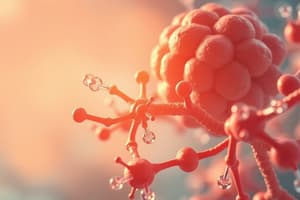Podcast
Questions and Answers
How do enzymes speed up chemical reactions in living organisms?
How do enzymes speed up chemical reactions in living organisms?
- By changing the temperature and pH of the reaction environment.
- By increasing the activation energy required for the reactions.
- By lowering the activation energy required for the reactions. (correct)
- By acting as a reactant in the chemical reaction.
During photosynthesis, what is the role of light energy?
During photosynthesis, what is the role of light energy?
- It is released as heat to maintain the plant's temperature.
- It is converted into chemical energy stored in glucose. (correct)
- It is converted into water and carbon dioxide.
- It is used to break down glucose into simpler molecules.
What is the primary difference between aerobic and anaerobic respiration?
What is the primary difference between aerobic and anaerobic respiration?
- Aerobic respiration produces lactic acid, while anaerobic respiration produces ATP.
- Aerobic respiration occurs in the mitochondria, while anaerobic respiration occurs in the cytoplasm.
- Aerobic respiration requires oxygen, while anaerobic respiration does not. (correct)
- Aerobic respiration uses carbon dioxide, while anaerobic respiration uses oxygen.
In what part of a plant cell does the Calvin cycle (light-independent reactions) take place?
In what part of a plant cell does the Calvin cycle (light-independent reactions) take place?
Which of the following statements correctly describes the relationship between photosynthesis and respiration?
Which of the following statements correctly describes the relationship between photosynthesis and respiration?
Flashcards
Enzymes
Enzymes
Proteins that speed up chemical reactions by lowering activation energy.
Photosynthesis
Photosynthesis
The process of converting light energy into chemical energy stored in glucose.
Light-dependent reactions
Light-dependent reactions
The first stage of photosynthesis occurring in thylakoid membranes using light energy.
Aerobic respiration
Aerobic respiration
Signup and view all the flashcards
Anaerobic respiration
Anaerobic respiration
Signup and view all the flashcards
Study Notes
Enzymes
- Enzymes are proteins that speed up chemical reactions in living organisms
- Enzymes lower the activation energy needed for reactions
- Enzymes are specific to their substrates (the molecules they bind to)
- Enzyme activity can be affected by factors like temperature and pH
- Example: Amylase breaks down starch into sugars in the mouth
Photosynthesis
- Photosynthesis is the process where green plants, algae, and some bacteria convert light energy into chemical energy stored as glucose
- This process happens in chloroplasts of plant cells
- The overall reaction is: 6CO2 + 6H2O + light energy → C6H12O6 + 6O2
- Photosynthesis involves two main stages:
- Light-dependent reactions (in thylakoid membranes)
- Light-independent reactions (Calvin cycle) in the stroma
Respiration
- Respiration is the process used by cells to break down glucose (or other molecules) to release energy in the form of ATP
- Two main types of respiration:
- Aerobic respiration (requires oxygen):
- Glucose + Oxygen → Carbon dioxide + Water + Energy (ATP)
- Occurs in mitochondria, highly efficient energy production
- Anaerobic respiration (does not require oxygen):
- Produces lactic acid in animals, ethanol and CO2 in yeast
- Less efficient compared to aerobic respiration
- Aerobic respiration (requires oxygen):
Studying That Suits You
Use AI to generate personalized quizzes and flashcards to suit your learning preferences.
Related Documents
Description
Explore enzymes, photosynthesis, and respiration. Enzymes speed up reactions, photosynthesis converts light to glucose, and respiration breaks down glucose for energy.




